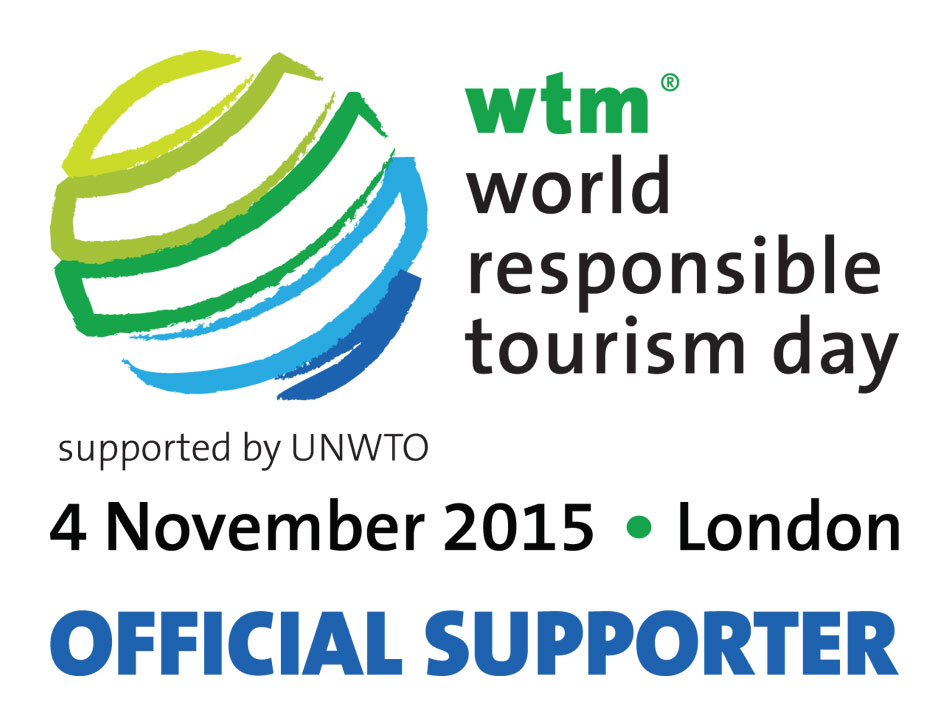Magadan Region Profile
LOCATION & GEOGRAPHY
The region is rich in mineral resources and is one of the largest gold-bearing areas in the world and the Russian leader by production of silver. CAPITAL: Magadan (founded in 1929, population 93,000 as od 2015) Read more about Magadan, a far-flung town in Russia’s Far East here
AREA: 462 500 km², rank 11th in Russia POPULATION & NATIONALITIES: 141 200 people (2019). The region is populated by more than 80 ethnic groups including small population groups of indigenous peoples (Evens, Koryaks, Itelmens and other). National composition: Russians 84%, Ukrainians 6,5%, Evens 1,7%, Tatars 0,9%.
CLIMATE
By thermal conditions of winter, this zone includes two types of climate: distinctly continental (subarctic) climate with severe winters and moderate continental and marine climate with moderately severe winters. The region's mean temperature of January makes -27 degrees Celsius; mean temperature of July reaches +30 degrees Celsius. Precipitation rate makes 20 mm in January and 60 mm in July. The winter in the Magadan Region lasts from 6 months in the south up to 7.5 months in the north. Stable snow cover is observed, on the average, by mid-October. HISTORY People settled in the Magadan region since the Paleolithic times. The ancestors of the Indians who came to America through Beringia, the land bridge between Siberia and Alaska, passed through the territory of the region. The indigenous tribes of Koryaks lived on the northern shore of the Sea of Okhotsk. They mastered the sea mammal hunting, domesticated reindeer and began to colonize the Kamchatka Peninsula. The continental part of the Magadan region, the upper Kolyma River and its tributaries were inhabited by Yukagirs - skilled hunters and fishermen with a rich oral literary tradition and even the rudiments of writing. In the 16th century, Evens, nomadic herders, began to settle in the Magadan region. The administrative subordination of Kolyma and Chukchi lands has changed multiple times. Thus, at the beginning of the XX century, almost the entire territory of the future Magadan Region, including Chukotka, was a part of Primorsky region and since 1909 it was a part of Kamchatka region.
Basically, the history of the future Magadan Region began in the 1920s, after scientific and geological survey expeditions arrived to Kolyma to explore the gold-bearing deposits. During the Stalin era, Magadan became a major transit centre for prisoners sent to the far eastern labour camps - or gulags. From 1932 to Stalin's death in 1953, Magadan was the administrative centre for the Dalstroi organisation (acronym for Far Northern Construction Trust), a wing of the secret police and a vast and brutal forced labour mining operation and forced labour system. Later, the town served as a port for exporting gold and other precious metals mined in the surrounding Kolyma region. In 1932, a workers' settlement, later converted into a city, was founded in the valley of the Magadan River. Magadan Region was founded in 1953. Its structure included the city of Magadan, 6 districts, and Chukotka National District. In 1992, Chukotka Autonomous District left the Magadan Region. NATURE PRESERVES / WILDLIFE SANCTURIES
Magadansky State Nature Reserve Area: 883,000 hectares Location: in the southeastern part of the Magadan region, on the territory of Ola and Srednekansky areas.
The territory of the reserve consists of four clusters 200-500 km away from each other: Kava-Chelomjinsky, Olsky, Yamsky and Seimchansky. These clusters of the total area of 883 800 ha present the significant part of landscape and biological diversity of the Okhotsk-Kolyma region - the vast and poorly developed part of the Russian Far East which by its area can be compared to many European countries. Each cluster has its own distinctive features in locality appearance, climate conditions, composition of flora and fauna. The central manor of reserve is located in the regional center - the city of Magadan. Very specific ecosystems almost not present outside the North-Eastern Eurasia are being preserved within the Reserve's area: continental larch sparse forests, Bering cedar tundra, Alpine and sub-Alpine landscapes of the Kolyma highland, mixed Erman's birch forests of the Sea of Okhotsk coast, broadleaf flood plain forests. Terrestrial mammals are presented by 40 species including wild reindeer, elk, bighorn sheep, brown bear, common otter, sable, Kamchatka marmot. The territory of the Magadan Nature Reserve includes a breeding ground of the Steller sea lion, which is listed in the Red Book of Russia and is also home to birds listed in the Red Book, including Steller's sea eagle – the symbol of the reserve, Baikal teal, small tundra swan, osprey, golden eagle, white-tailed eagle, peregrine falcon, Far Eastern curlew, common owl, and fish owl. Have a virtual tour in the reserve by this link Kava-Chelomdzhinsky cluster of the reserve "Magadansky"
Area: 624 456 hectares Location: in the southwestern part of the Magadan region in the transition zone of the Kolyma Upland to the Taui coastal plain of the Sea of Okhotsk
The main objective of the cluster is to preserve the characteristic landscapes of the Okhotsk macro-slope, foci of diversity of its flora and fauna, spawning grounds of Pacific salmon, Priokhotsky populations of animals and birds. A wide range of habitats supports the high floristic and faunistic diversity of the site. 387 species of vascular plants, 17 species of fish, 2 species of amphibians, 156 species of birds, and 35 species of mammals are noted here. Of the rare species listed in the Red Book of Russia, protected on the site are: Alpine blackberry and 12 bird species - Steller's sea eagle, golden eagle, osprey, peregrine falcon, Siberian taiga gooseberry, killer whale, kloktun, large spindle-tree, Dubrovnik, red-necked grebe, Far Eastern Curlew, fish owl. Simchansky cluster of the reserve "Magadansky" Area: 117 839 hectares
Location: in the Kolyma river valley within the Balygychan-Suksukan intermountain basin.
On the Simchansky cluster, a variety of floodplain and valley landscapes, wetlands and mountain taiga lands are preserved. The flora of the site includes 307 species of vascular plants. These are mainly typical plants of the northern taiga strip. Unlike other parts of the reserve, 25 species of freshwater fish live on the territory of the Simchansky site, most of which are widespread in Siberian water bodies, but do not penetrate into the basins of the Sea of Okhotsk. Pike, perch, fine-tailed burbot, Siberian dace are often found on the channels of the Kolyma River, East Siberian grayling lives in mountain tributaries. On the site, 2 species of amphibians (Siberian coal-toothed and Siberian frog), 34 species of mammals and 131 species of birds were also noted.
Olsky cluster of the reserve "Magadansky" Area: 103 434 hectares
Location: in the south of the Magadan region at a distance of 100 km from the regional center and occupies the western part of the Kony Peninsula. This is one of the most unique sections of the northern coast of the Sea of Okhotsk, characterized by the greatest plant diversity in the entire Magadan region, which includes endemic species of various regions and relicts of different ages and origin, many of which are listed in the regional Red Book. In spring, the slopes of the peninsula fascinate with a variety of flowering rhododendrons, Ledum and Cassiopeia. Forests are rich in berries and mushrooms.
On the coast of the peninsula with picturesque bays and rocky capes, life is always boiling: snow sheep graze, fox and ermine hunt, and the Steller's sea eagle nests. However, the true owner of the peninsula is a brown bear. Most of these predators gather in the summer, during spawning - clubfoot approach the mouth of the river to enjoy pink salmon. Three species of real seals live in the coastal waters of the peninsula The peninsula is an intersection spot of arctic and arctic-alpine species' southern migration routes and routes of' Far East species moving to the north. Yamsky cluster of the reserve "Magadansky" Area: 38 809 hectares
Location: in the valley of the lower reaches of the Pit - 180 km east of Magadan and 20 km from the small village of Yamsk, including Yamskiye Islands, shore zone of the Pyangin Peninsula. Yamsky coastal cluster - features the disjunctively located part of Siberian spruce areal on the north-eastern edge of its distribution. The cluster is distinguished by the high biodiversity and the abundance of relic dark-coniferous plant species. Along with the centers of growth of Siberian spruce, spawning grounds of Pacific salmon - chum and coho salmon, which are considered the largest in the northern part of the Sea of Okhotsk.
Yamsky marine cluster - features the peculiar vegetation of the bird bazaars of Yamsky islands which had apparently been formed as the result of long-time interaction of birds and coastal vegetation. In the area of the Yamskiy Islands, located at the exit from the Shelikhov Bay, the highest concentration of plankton in the Sea of Okhotsk is noted, and the bay itself is one of the most productive water areas of the World Ocean. Colonies of seabirds of 12 species, with a total number of up to 5.9 million individuals are present on all islands. TOUR SIGHTS OF INTEREST Every second Magadan climbed to the highest point of the city - the Marchekan hill, to meet the dawn one of the first in the country. It is the highest point of the Staritsky peninsula, has a height of 705 meters. At the top of the hill offers a breathtaking view of the surroundings of the city of Magadan. Four large bays surrounding the Staritsky Peninsula - Nagaev, Gertner, Merry, Light - appear in full view. The special popularity of the Marchekan hill among the townspeople is no coincidence, you can climb it from one of the central streets of the city of Magadan. Nagayev Bay is narrow and elongated, deeply cut into the land of the Okhotsk Sea. It is believed that construction of Magadan's administrative center started at this bay. At that time, ships were unloaded manually using smaller boats. The construction of a commercial seaport began only in 1933. Nowadays, there is a first-class seaport in Nagayev Bay. Berths are occupied with diesel electric freight vessels and tankers that deliver hundreds of thousands of tons of cargo. Very picturesque bay may attract many nature lovers. The shores of the bay are steep and there is a narrow sand line at low tide. To the left you can see the peninsula of Staritskiy, where there is the natural monument «Kamenniy Venets» (Stone Crown), a pile of stones resembling a crown on a rocky mountain, which is very popular among locals and visitors of the city. There are few more attractions on the shores of the bay: a monument to the Soviet singer and poet Vladimir Vysotsky; a monument to the Pioneers of the Kolyma and Chukotka; the monument “Uzel Pamyati” (“Memory Knot”), dedicated to Magadan residents - the heroes of the Second World War; a monumental sculpture of a mammoth who lived in the past in these lands called “Vremya” (“Time”); and a small marine park with a playground. Talan Island is a rocky butte located on the western edge of Taui Bay, nearly 100 kilometers from Magadan, in Olsky District. On a clear evening, the island can be seen on the horizon from the coast of Nagaev Bay. It is a federally-protected natural monument. The area of the island is nearly 2.5 square kilometers. The top of the island is a flat plateau with rocky ridges and boggy meadows. The island is especially popular among scientists, researchers, and photographers, because it is home to one of the largest colonies of birds in the northern part of the Sea of Okhotsk. The total bird population is about 1.8 million species. Almost from all areas of the city you can see the Mask of Sorrow Monument thatcommemorates thousands of prisoners who suffered and died in the political purges of the 1930-50s, it is located on the Krutaya Sopka hill. Somewhat controversial, the fifteen meter monument was designed and created by sculptor Ernst Neizvestny, whose parents fell victim to the Stalin purges of the 1930's. The structure was built by Kamil Kazaev. A brutal cement structure; a face with tears streaming down the left eye in the form of small masks; the right eye in the form of a barred window. Eleven concrete blocks bearing the names of the most terrible forced-labor camps in Kolyma were installed on the front of the monument. At the back a young woman weeps. Above her is a headless man on a cross. Inside is the replica of a small Stalin-era prison cell. Below are stone markers bearing the names of many of the worst forced-labour camps of the Kolyma, as well as stones carved with various religious symbols. A welcome relief to the reminders of the gulags was the site of the beautiful Holy Trinity Cathedral. With its splendid golden onion domes and striking white and gold arches, the church was a magnificent example of fine Russian architecture. This striking cathedral would catch your eye almost anywhere, but in Magadan its beauty is instantly noticeable against the backdrop of grey apartment buildings and even the grandest weathered facades. Within an hour’s drive from Magadan there is Lake Solyonoe (Salty). Lake Solyonoe is a shallow pond separated from the Sea of Okhotsk by the pebble strip. The lake water is crystal clear and not salty, it is fresh. The reason it is called salty probably has to do with the fact that during high tides and storms, sea water flows over the embankment, making the lake a little salty. Spafaryev Island located in Taui Bay, 100 km from Magadan is 13 km long and consists of two mountainous parts connected with a low landstrip the width of which 300 meters. The island was discovered in 1740 by Vitus Bering and for many years had been known as Korovy Island because of sea lion rookeries. Only in 1912, the island was renamed after Spafaryev, a famous explorer of the Baltic Sea. In the northern part, there is a conic Komandor Bering Mountain, the highest part of the island. Near this mountain located high lighthouse. The local island population is several people: meteorologists and hydrologists, basically. The island is inhabited by foxes, hares and bears. Coastal waters are rich in fish, especially herring. The unique cascading waterfall «Golovnye» in the wild northern tundra on one of the hills near the city of Magadan. The waterfall looks breathtaking in early summer, when the stream is overflowing with meltwater. The water falls to the bottom of the gorge from 30 meters and rumbles in the forest silence. If you visit this place in autumn, you can pick cowberries and rowan. This is also brown bear habitat zone. Gertner Bay fascinates with its northern beauty: even in June there are many ice floes. The bay is located in the Taui Bay of the Okhotsk Sea. The shores of Gertner Bay with narrow sand and pebble beaches are not only for enjoying the pristine nature of the Magadan Territory and sunbathe, but also for fishing. Among trophies of fishermen are navaga, crab, smelt. For recreation on the territory of the bay, the Gornyak recreation area is equipped. Holidays, festivals, tourism events are regularly held on the coast, including the Golden Festival of the Magadan Region and the national holiday “Habdenek”. The Three Brothers Islands there are the symbol of the Gertner Bay and the city of Magadan, often appearing on local postcards. They located in front of Vostochny Cape, just 1 km away from the shore. The smallest of the Brothers is a tiny stack of stone blocks with a spire on top. The medium one a bit bigger and taller, and the third Brother is a 75 meters high conic island. Gulls and tufted puffins nest on it. Cape Nyuklya (Sleeping Beauty) is the rocky ledge, extending far into the sea, from afar really resembles a sleeping girl from children's fairy tales. For most of the year, among the black cliffs of the cape, are blinding whiteness spots and "ties" of snowfields. In early summer, the slopes are covered with purple flowers of the local snowdrop - “sleep grass”. A panoramic view of Nyuklya is considered one of the main attractions of the Magadan region. The most beautiful view opens from high banks on the eastern side of the cape. The Yamsky archipelago is a group of five islands: two large - Matykil and Atykan, and three small - Baran, Hatemalyu and Kokontsa. The archipelago also includes several stone pillars. The islands have preserved the original landscapes. Of the locals here - only sea lions and seabirds. The colonies of seabirds of the Yamsky Islands are the largest in Russia and one of the largest in the northern Pacific Ocean. Dancing Grayling Lake is located in the Yagodninsky district of the Magadan region on the Upper Kolyma plateau. One of the shores of the Dancing Grayling Lake is gentle and overgrown with sedge, the other is elevated, stony. In the center of the reservoir there is a group of tiny islands, the area of which allows you to put there no more than a tent. The lake seemed to be sandwiched between hills, long and narrow, but not deep - only 22 meters. Its narrow mirror in the palms of larch slopes resembles the fjords of Norway. The lake got its name thanks to one of its inhabitants - a small fish grayling. It is unique not only for its beauty, but also for a phenomenon such as the "grayling dance." They really dance here. At sunset or sunrise, when a midge appears on the surface of the lake, the lake’s waters seem to boil, and hundreds of graylings jump out of the water in pursuit of a treat. Magadan Region is leading in Russia's gold and silver mining. Kolyma produces about 24.5 tons of gold annually. Large-scale investment projects are being implemented in the region, new deposits, such as Natalka and Pavlik, which are one of the largest reserves in the world, are being developed. The balance reserves of gold at the Natalka deposit are 1,450 tons, silver — 331 tons. At the Pavlik deposit, the established reserves of gold and silver are more than 154 tons and 39.8 tons. Magadan is the scientific and cultural center of the region. The city has two theaters, museums, art galleries, festivals, concerts, fairs. Everything about the nature and ethnography of the North, the history of the Magadan region during the Dalstroy period can be found on excursions in The Magadan Regional Museum of Local Lore, one of the largest scientific and educational institutions in the North-East of Russia. The exposition of the Museum "Nature of the North" introduces the flora and fauna of the North-East of Russia. Here are the bones of the skeletons of ancient animals: mammoth, woolly rhinoceros, musk ox. Among the exhibits are unique finds: a replica of the famous mammoth Dima, found in the permafrost. At the exhibition "People of the Earth and the Sea" the life and culture of the indigenous peoples of the North are widely represented. A separate museum hall tells the story of the Stalinist repressions in the Magadan region. It also collected objects from places of former camps: a security tower, bars from heavy-duty barracks, household utensils, preserved documents and letters. Exhibition “Kolyma. Sevvostlag 1932-1956” became one of the first such expositions in Russia. The Museum of Natural History of the Northeast Complex Research Institute of the Far Eastern Branch of the Russian Academy of Sciences has long been one of the sights of the city of Magadan. It contains geological-mineralogical and ethnographic-archaeological collections reflecting the complex geological history of the development of the Northeast, giving an idea of the region’s mineral resources and some unique natural objects, as well as illuminating the history of human cultures of Northeast Asia. Jack London Lake is the remote paradise with stunning scenery located near the village Yagodnoe, 570 km from Magadan city. The lake is 10 kilometres long and some 50 metres deep. Four islands lie in its waters. It was geologist Pyotr Skornyakov who in 1932 decided to name this clear water lake after Jack London, whose work enjoyed popularity in Soviet times. EVENTS Magadan’s “trick” is considered to be Russia's only gold washing championship “Prospector's Luck”. On the day of the holiday, anyone can try themselves in the profession of a prospector and compete for a valuable prize of more than a million rubles. Every year in the middle of summer, «prospectors» from all over the Magadan region, as well as from other regions of Russia, gather in the Gertner bay to take part in the Prospector's Luck gold washing championship, which takes place within the framework of the All-Russian Gold Festival. Participants compete in the skill of washing gold in the traditional way. During the competition, «prospectors» wash the gold-bearing soil with a large amount of water, large pieces of the rock must be crushed. Excess material is washed away, and gold particles that are heavier than the soil remain at the bottom of the rinsing vessel. Grains of the precious metal can be quite small, but it's a great success, because the cost of gold is very high. “Bakyldydyak” - translated from Even “meeting”, a celebration of the meeting of friends and the first fish. This is one of the oldest Even events, which was revived in 1992 and is held on the territory of the Magadan Region once every two years. It is dedicated to beginning of salmon sprawling and is celebrated on the Nyuklya Spit 35 km from Magadan. The first fish holiday makes an invaluable contribution to the preservation of the ethno cultural traditions of the northern peoples. It is here that guests will be able to observe the ancient Even rites: “Meeting the guests”, “Lighting and feeding the sacred fire”, “Feeding the net”, “Rite of worship of the spirit of the sea”, as well as take part in competitions in northern all-around events and get acquainted with the traditional Even seals ritual. Masters of arts and crafts will present products made of fur, leather and beads, on the basis of traditional crafts of the peoples of the North at the Unili exhibition. Traditionally, public organizations of indigenous peoples of the North will take part in the festival. The Even celebration of the New Year's Eve on the Even calendar of people “Habdenek” is one of the most striking, large-scale and revered holidays at the Kolyma residents and the indigenous peoples of the North. According to the Evens, in the summer, the Meeting of the New Sun and the New Year sets in - is the verge when the old year dies and a new one is born. The longest day - the summer solstice – is being the first in the new year for the Evenks. On a festive day, the elders of the families kindle a sacred fire, perform a purification ceremony with the smoke of a juniper, and conduct roundelays. Evenks make New Year wishes, tying a piece of cloth to a tree branch: according to the beliefs of this people, on the day of the summer solstice it is much easier to convey their requests and desires to the higher powers. The regional folklore celebration of the New Year according to the Koryak calendar “Tuigivin” takes place on the eve of the winter solstice. A large festive program takes place on Theater Square in the center of Magadan. At the festival, the indigenous inhabitants of the region conduct traditional national ceremonies: “Hololo”, “Lauthen” and “Ulyau”. In addition, Tuigivin’s program includes performances by creative folklore groups of the region, competitions and national games. The sea breeze in Nagaev Bay inspired the organizers of the «Air» festival to start the first improvised mass kite flying. As years have passed, it has grown into a colorful summer event dedicated to flying and attracts many visitors – locals and tourists as well. The Mask of Sorrow memorial in Magadan commemorating victims of political repression.
Alexander Krylov/RIA Novosti
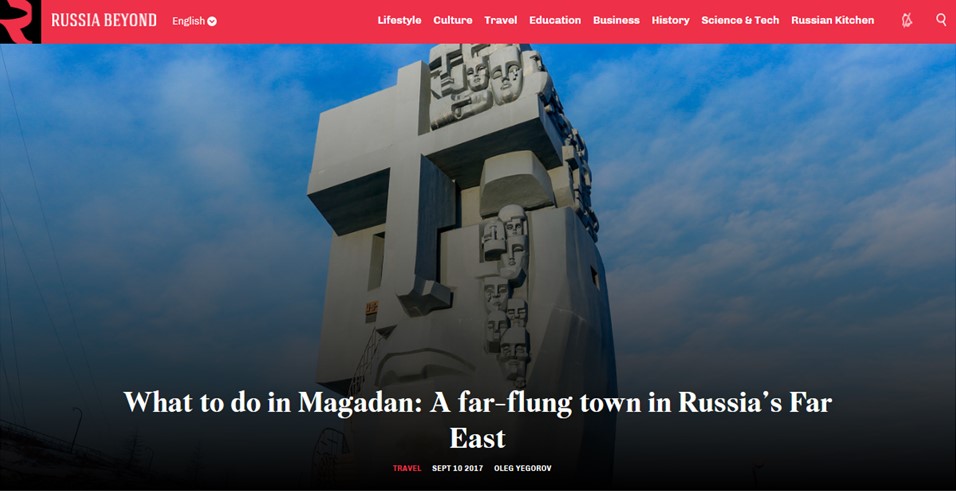 While it may not be an obvious tourist destination, the capital of the Kolyma Region in the Far East has a lot to offer travelers — from its miraculous natural surroundings to an assortment of museums and monuments inside the city. While it may not be an obvious tourist destination, the capital of the Kolyma Region in the Far East has a lot to offer travelers — from its miraculous natural surroundings to an assortment of museums and monuments inside the city.“Life here is different from what other Russians have on the continent,” locals in Magadan often say. If you react to this with surprise, because their city (6000 kilometers east of Moscow) is definitely not an island, they’ll just laugh.
Their home region of Kolyma, sitting between the basin of a river with the same name and the northern shore of the cold Okhotsk Sea, does indeed resemble a separate island — no trains go there, and the closest big city, Yakutsk, is 2000 kilometers to the west. The only reliable way to get to this remote place is by plane — either from Moscow or the cities of Siberia and the Far East (Vladivostok, Khabarovsk, Irkutsk and so on).. to continue
While it may not be an obvious tourist destination, the capital of the Kolyma Region in the Far East has a lot to offer travelers — from its miraculous natural surroundings to an assortment of museums and monuments inside the city. To continue reading click here
Read the article here
|
|
World time
--:-- :--
--.--.--
Our TOURS by CategoryOur Special ServicesSearch
Send an e-mail:
|
language: ENG / RUS
© All rights reserved by Absolute Siberia LTD.
|
Weather in Irkutsk
Our NEWS 25.02 2015 15.05 2013 |



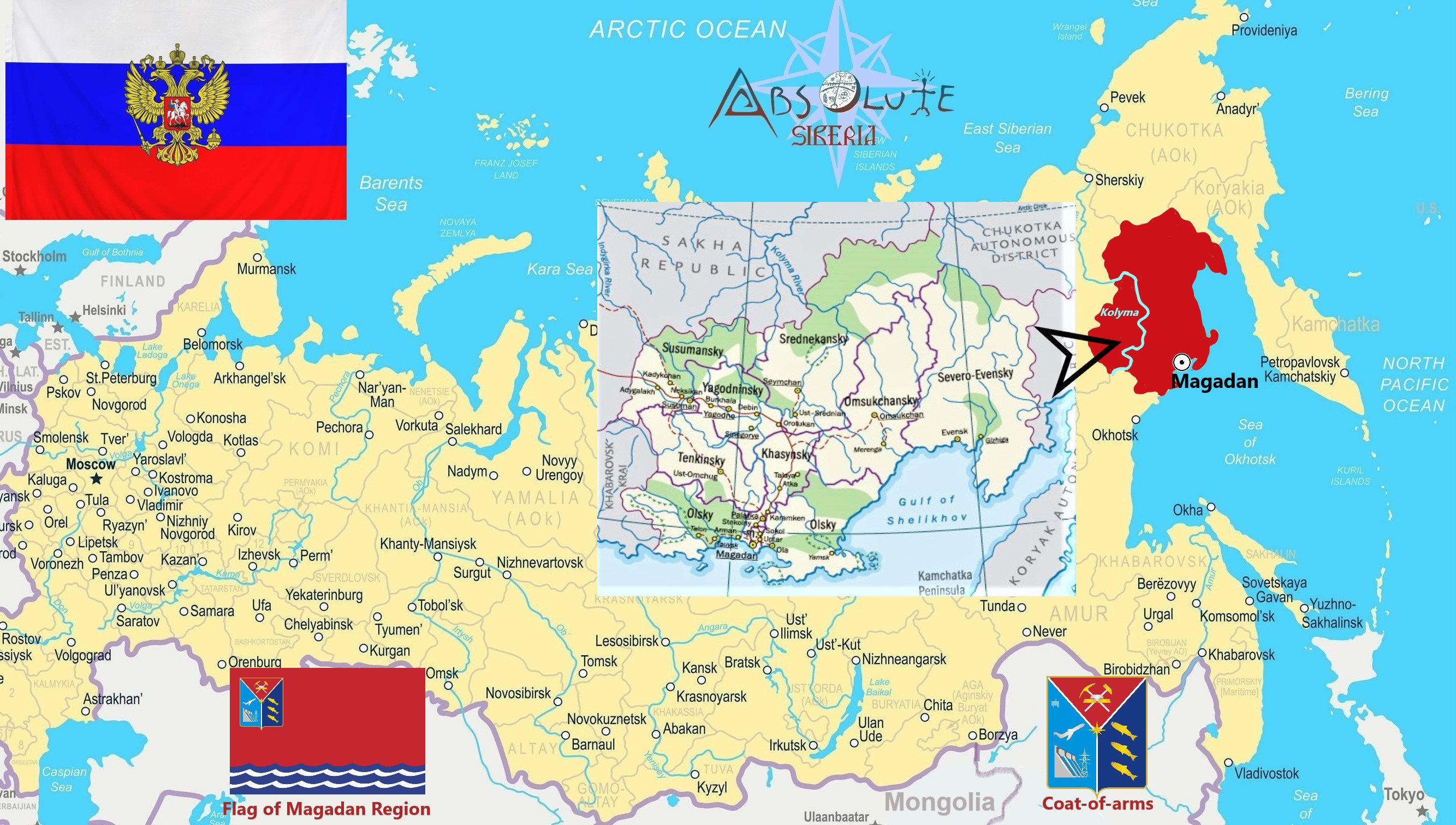
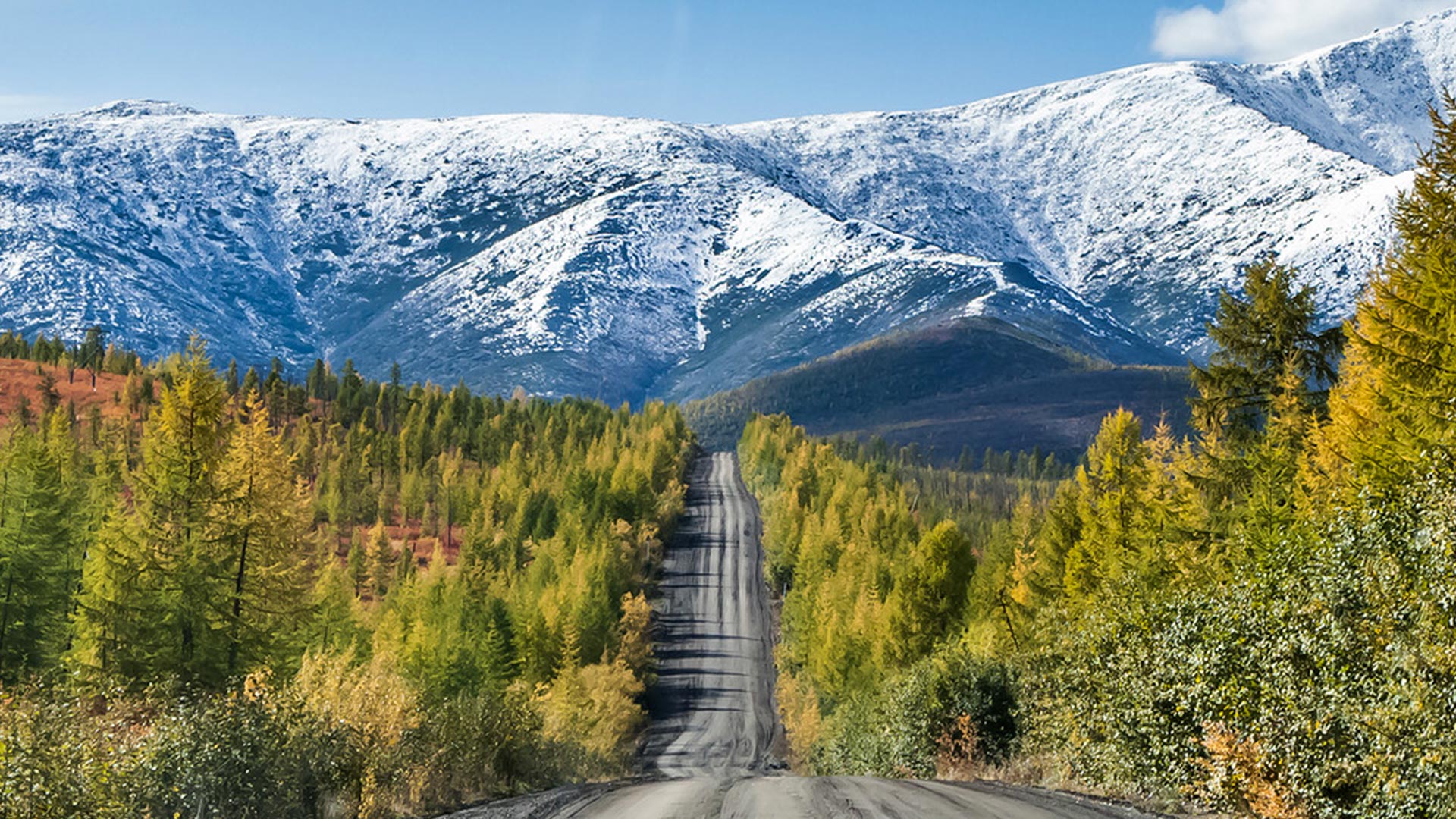 Magadan Region is one of the Russian Far North regions with the severe climate. It lies in the northeastern edge of the Asian continent and is a vast territory with complex and diverse relief, washed from the south-east by the cold waters of the Okhotsk Sea which is a part of the Pacific Ocean. From the south-east the region borders Kamchatka Krai, from the west - Khabarovsk Krai, from the north-west - the Republic of Sakha (Yakutia), from the north-east - Chukotka Autonomous Region. The land borders stretch across the mountain areas, while the southern border between the Magadan Region and the countries of the Asia-Pacific basin is a sea border.. Yakutsk, the nearest city, is located about 2,000 km from Magadan. The distance from Magadan to Moscow by motor roads makes 9,709 km, to Irkutsk 4,700 km.
Magadan Region is one of the Russian Far North regions with the severe climate. It lies in the northeastern edge of the Asian continent and is a vast territory with complex and diverse relief, washed from the south-east by the cold waters of the Okhotsk Sea which is a part of the Pacific Ocean. From the south-east the region borders Kamchatka Krai, from the west - Khabarovsk Krai, from the north-west - the Republic of Sakha (Yakutia), from the north-east - Chukotka Autonomous Region. The land borders stretch across the mountain areas, while the southern border between the Magadan Region and the countries of the Asia-Pacific basin is a sea border.. Yakutsk, the nearest city, is located about 2,000 km from Magadan. The distance from Magadan to Moscow by motor roads makes 9,709 km, to Irkutsk 4,700 km.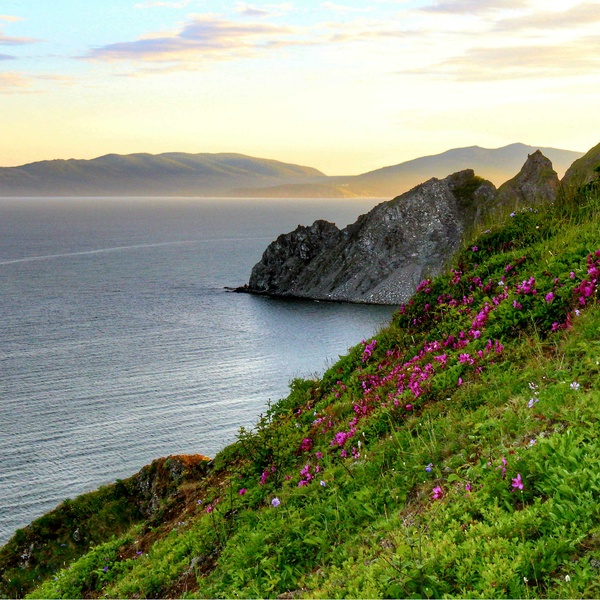 The region's territory is located in two severe zones of the Far North - tundra and forest-tundra. Specific features of these zones include excessive moisture, cold summers, and snowy winters. Almost the entire territory of the Magadan Region is located in the permafrost zone. The climate is harsh, with short summers, which accounts for the period of "white nights" that persist throughout the summer: a time when the sun barely sets below the horizon.
The region's territory is located in two severe zones of the Far North - tundra and forest-tundra. Specific features of these zones include excessive moisture, cold summers, and snowy winters. Almost the entire territory of the Magadan Region is located in the permafrost zone. The climate is harsh, with short summers, which accounts for the period of "white nights" that persist throughout the summer: a time when the sun barely sets below the horizon.



